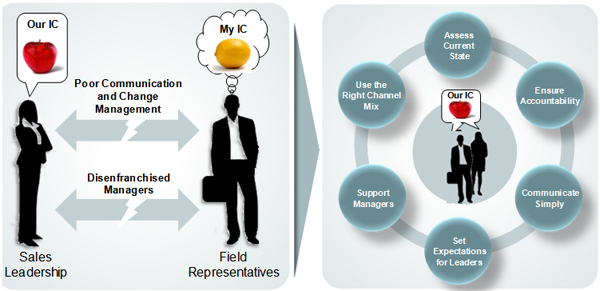
Sales leaders often launch compensation plans with great fanfare, and then they are disappointed when employees don’t understand the plan or believe it’s fair.
What’s the problem? It’s true that compensation plans are often complicated, but complexity could just be a smokescreen for the two true root causes:
- Communication that isn’t clear enough, doesn’t allow reps to ask questions and is over before reps understand the plan.
- Disenfranchised managers who don’t really understand the plans, so they aren’t equipped to explain them.
To engage employees in your compensation program, you need an approach based on proven change communication. In this article, get six key strategies, along with a case study example that demonstrates how to use these strategies to gain buy-in.
Case study
Three months into the new incentive program, product sales have barely moved at Widget Co. Paul, the new COO, meets with his VPs of Sales, Sales Operations and HR. “Why aren’t we seeing better results?” Here’s what his VPs tell him:
“Restructuring has affected the morale of old-timers; new folks are still figuring out their roles.”
“The flex-selling model — with specialists and account reps sharing territories — is confusing.”
“I’m not sure our managers understand the implications of the changes we’ve made.”
Strategies to Build Buy-In
- Assess the current state
To avoid making unfounded assumptions about compensation programs, it’s critical to conduct a thorough assessment of the current state, including an objective evaluation of the compensation program itself, as well as feedback from sales reps on their perceptions and preferences.
Paul forms a cross-functional team that partners with a consulting firm to conduct a “health check” of the compensation program.
The assessment indicates that the program design is sound but understanding is low.
- Ensure accountability
In many organizations communication responsibilities are unclear or split among multiple groups. What’s needed is a dedicated cross-functional team that focuses on helping sales reps understand how the compensation plan has changed and how to succeed.
Once the assessment is completed, Paul establishes a Compensation Communications Task Force. This team includes HR and Operations managers plus representatives from a new group called the Compensation Governance Council. The council consists of selected reps and managers to provide input into program design, become experts on the program and serve as field ambassadors.
- Communicate with plain language and visuals
When designing a new compensation program, it’s typical to create a statistics- and detail-heavy PowerPoint deck for senior management (typically evaluating multiple options). The problem occurs when the same document is used as the foundation for communication to the field. Not surprisingly, it usually falls flat.
Busy reps need relevant messages in a simple form they can digest immediately, using tables, graphs and other visuals.
Feedback indicated that there was one question that the field cared most about: “How can I maximize my bonus earnings on this plan?”
Widget Co.’s team creates a simple message platform to communicate the compensation program:
- A theme and logo of “Scaling the Peak” to denote peak earnings in the compensation plan
- A scaled-down presentation with a more visual approach and focus on key field questions
- Set expectations for leaders
The typical annual sales meeting agenda is packed with presentations about an array of topics. A senior leader presents the compensation plan and strongly endorses it. But sales reps won’t fully understand and buy into the plan unless trusted leaders communicate repeatedly and consistently.
At the National Sales Meeting, Paul speaks to the compensation plan as part of his keynote, and there are district-level breakout sessions where representatives learn details of the incentive plan from their managers.
He continues the communication theme in:
- His weekly “all-hands-on-board” teleconferences, Paul acknowledges individuals who are excelling on key aspects of the compensation plan.
- As he travels to regional meetings and on field ride-alongs, Paul reiterates to his managers that they need to own the incentive plan.
- Provide managers needed support
In survey after survey, employees pick “my manager” as their most trusted source of information. Yet, in many organizations, managers aren’t effective interpreters.
The best approach to achieve this is having focused training for managers in which they can explore the incentive plan, answer questions and prepare to communicate.
Two weeks prior to the NSM, WidgetCo. hosts a series of Web-based “train-the-trainer” sessions for field managers.
In the week before the NSM, managers are encouraged to take an online self-assessment on the compensation plan.
- Use the right mix of channels
It’s necessary to use the channel that is most appropriate for the message and audience, and to be more inventive about how you use communication channels.
The key is to repeat messages in many forums, making sure you incorporate compensation messages into existing channels like weekly e-newsletters or monthly calls. Don’t forget to seek opportunities to tap into new media your salesforce is using, including microblogs and social networking.
WidgetCo. identifies various ways to keep the compensation program top of mind, such as:
- A wallet card that provides highlights of the program
- A “Sales Pulse” newsletter with a “sales compensation question of the month” section

Ram Moorthy is a Principal with ZS Associates and plays a key role in ZS’s sales compensation, salesforce effectiveness and sales performance reporting practice areas. Email:ram.moorthy@zsassociates.com.
Alison Davis is CEO of Davis & Company (www.davisandco.com), an employee communication firm that helps companies reach, engage and motivate employees. Email: alison.davis@davisandco.com.



